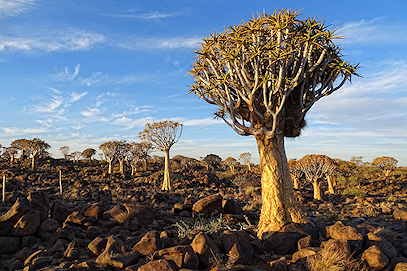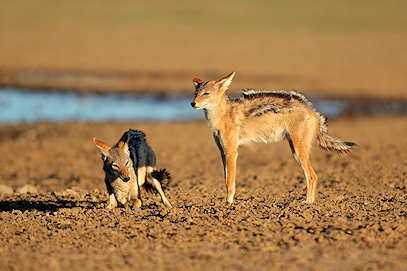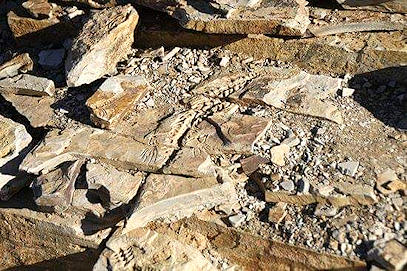Kalahari
The Kalahari Desert stretches across Namibia, Botswana, and South Africa. Within the Kalahari, you will find several game reserves, of which the Central Kalahari Game Reserve, Khutse Game Reserve, and the Kgalagadi Transfrontier Park are the most prominent. African Sky can tailor-make safari experiences to the Kalahari.
Need Advice?- Home
- >>
- African Travel
- >>
- Namibia
- >>
- Kalahari
Overview
The Kalahari's biggest attraction is its silence and solitude. You can encounter many animal, plant, and bird species on game drives and walking trails.

The Kalahari is home to the few remaining hunter-gatherers of Southern Africa – the San (or "bushmen") – who survive by hunting with their bows and arrows. They also gather plants like berries, as well as insects and nuts. Bushmen can get by without drinking much water, receiving water from the desert melons they eat, and storing water in empty ostrich eggshells.
Reasons to Visit the Kalahari
Unique Desert
It is not a desert consisting purely of dunes but rather a land of dunes with grass plains. There is more vegetation than in a typical desert, resulting in more animals that inhabit the region. By visiting the Kalahari, you can see the desert, exciting plants, and fascinating animals such as the meerkat.
Panoramic Views
The Kalahari in Namibia is home to some of the most striking salt pans. With entire parks named after the salt pans found in their regions, it is no wonder that they count amongst the main attractions of the area. The pans cover a large area of the Kalahari Basin and form the bed of ancient lakes. They make for extraordinary views and offer astonishing photographic opportunities.
Follow the San
The San people, who have lived in the Kalahari Desert for 20 000 years, still live there today. They live in huts built from natural materials and still live as their hunter-gatherer ancestors did. You will meet these incredible people when you visit the Kalahari in Namibia.
Experiences to Savor
The Kalahari in Namibia has unique vegetation, fossil sites, and awe-inspiring wildlife.

Quiver Tree Forest
At the Quiver Tree Forest, situated just 13km northeast of Keetmanshoop, visitors walk amongst the fascinating quiver trees and the dolerite rock formations known as "The Giant's Playground."
Sandy Safaris
You will be surprised at the diversity and number of animals seen in the Kalahari Desert. The best time of year to view wildlife is in the winter months – June to August. You can expect to encounter the black-maned Kalahari lion, springbok, gemsbok, red hartebeest, and many more.
Mesosaurus Fossil Site
You can go on a guided tour of the Mesosaurus Fossil Site outside Keetmanshoop. These rocks and fossils are amongst the most convincing evidence of continental drifting. Both fossils and rocks have the same composition as rock formations in South America.FAQ
Useful Travel Info
By Air
There are no commercial flights to the Kalahari Desert, though the area does host several private airstrips. Guests will be welcomed at OR Tambo International and assisted in boarding a flight to Windhoek Hosea Kutako International Airport, conveniently situated on the edge of the Kalahari. Guests may then take a light aircraft to their lodge in the Kalahari, depending on the destination.
By Road
The Kalahari is in the eastern part of Namibia. The desert is extensive, and various lodges are hours away from each other. From Windhoek Hosea Kutako International Airport, the closest lodge is just under 200km away. If you are not flying directly to one of the lodges, the private 4x4 drive allows you to see a more significant part of the country.
It can get hot. During the summer, temperatures can climb to 45 degrees Celsius during the day. The "desert" rarely receives more than 100mm of rainfall a year, and most of the rain is thunderstorms that rage in the Kalahari Basin between December and April.
The dry season, in the winter months from June to August, is better for viewing animals, as the animals congregate around waterholes and riverbeds to find water. The average temperature is around 25 degrees Celsius, which is pleasant. The nights are freezing, so you should bring warm clothes.
The Kalahari existed as an inland sea during the Cretaceous period between 65 and 135 million years ago. The fossil dune fields have documented periods of greater humidity and more aridity. David Livingstone was the first European to cross the Kalahari Desert in 1849. The Voortrekkers also traveled across parts of the Kalahari Desert in the 1870s. Many people and cattle died on this journey due to the lack of water.
The indigenous people of the Kalahari Desert are the San, also called the Bushmen. San is a Khoikhoi word meaning "outsider." The San were the first inhabitants of Southern Africa. Evidence suggests that they have been living here as hunter-gatherers for at least 20 000 years. The name "Bushmen" was given to them by Europeans traveling across the Kalahari Desert. They were so named because they lived in the bush and smelled like the bush because they rubbed the aromatic spices from various brushes into it their skin.
There is rich wildlife in the Kalahari. The animals here had to adapt to the harsh conditions. They can live for long periods while being deprived of water. Animals found here include rhinoceroses, elephants, lions (both Transvaal lions and Katanga lions), meerkats, African leopards, wild dogs, gemsbok, and social weavers.
There are also many snakes in the Kalahari Desert, as the warmth attracts them – especially Cape cobras and puff adders. Birds of prey include the secretary bird, eagles, owls, falcons, goshawks, kestrels, and kites. Karoo lark can also be seen. Many animals in this desert are migratory - the most successful species are those that can breed all year round whenever there is enough water available, like springbok.
It is one of the five geographical areas that make up the country of Namibia. The arid, vast expanse of sand is also the country's most well-known geographical trademark. The desert - although incorrectly titled so, as it receives too much rain to be classified as a desert – spans almost 930 000 km2 across Namibia, Botswana, and South Africa. It is the most significant part of the 970 000 km2 Kalahari Basin, stretching further north into Angola and Zambia. Even though the area receives rainfall above 100 mm annually, it is a thirstland.
The dunes, although not very high, are renowned for being the largest continuous expanse of sand on earth and surprisingly rich in vegetation, with over 5 000 species of plant identified in the desert. Grass clumps, shrubs, and deciduous trees grow sporadically, providing much-needed sustenance to the various animals and people in the area. Wild cucumbers, creeping melons, gemsbok cucumbers, and Hoodia cactus are some endemic edible plants, while the camelthorn, acacia, and kokerboom trees are the most noticeable. The trees play an essential role in providing shade and instilling growth in other plants by creating nutrient-rich earth.
Exploring by 4x4 is one of the easiest and best ways to take in as much of what the region offers. Photographic and cinematographic opportunities are endless, from the red dunes, the kokerboom forest, and the Mesosaurus fossil site to the breathtakingly beautiful sunsets. Stargazing in the desert is the perfect way to relax after a day of venturing through the harsh landscape.
Guided game drives offer excellent wildlife viewing, which includes the chance to encounter the elusive cheetah or the formidable black-maned Kalahari lion. Various antelope, such as springbok, gemsbok, and zebra, can also be seen. Walks accompanied by expert guides are available and offer visitors a chance to acquire a more in-depth knowledge of the area. Horse riding is available at some lodges in the area, and it's a great way to experience the outdoors at the same time as keeping fit. Remember to pack a water bottle or two.









